Managing Fertigation Frequency and Level to Mitigate N2O and CO2 Emissions and NH3 Volatilization from Subsurface Drip-Fertigated Field in a Greenhouse
Abstract
:1. Introduction
2. Materials and Methods
2.1. Descriptions of Study Area
2.2. Experimental Design
2.3. Agronomic Practices
2.4. Gas Sampling and Analyses
2.5. Ammonia Volatilization Measurement and Analyses
2.6. Soil Analyses
- E. buffer solution (dilute imidazole in 800 mL of distilled water. Adjust pH to 8.2 ± 0.1 with hydrochloric acid (32%). Add distilled water to 1 L, add Brij35 and mix
- F. Buffer solution (dilute ammonium chloride in 800 mL distilled water. Adjust pH to 8.2 ± 0.1 with NH3. Add distilled water to 1 L, add Brij35 and mix)
- G. Color developing solution (dissolve phosphoric acid in 700 mL distilled water, adding sulfonamide and α- Naphthyl ethylene diamine, add distilled water to 1 L and dissolve). For NH3 nitrogen, we have prepared 4 kinds of buffer solutions:
- A. buffer solution (in distilled water, dissolve potassium sodium tartrate and sodium citrate, set the volume to 1000 mL, add Brij 35 (30%), and thoroughly mix)
- B. Sodium salicylate solution
- C. Sodium nitroprusside solution
- D. Sodium dichloroisocyanurate solution.
2.7. Statistical Analysis
3. Results
3.1. Soil Temperature, Relative Humidity, and WFPS
3.2. Soil Inorganic Nitrogen
3.3. N2O and CO2 Fluxes
3.4. NH3 Volatilization
3.5. Crop Yield and Yield-Scaled Global Warming Potential
4. Discussion
4.1. Effect of Subsurface Drip Fertigation Frequency and Irrigation Level on Soil Inorganic N
4.2. Effect of Subsurface Drip Fertigation Frequency and Irrigation Level on N2O and CO2 Emissions and NH3 Volatilization
4.3. Influence of Subsurface Drip Fertigation Frequency and Irrigation Level on Chinese Cabbage Yield
4.4. The Implications of Subsurface Drip-Fertigation Management
5. Conclusions
Author Contributions
Funding
Institutional Review Board Statement
Informed Consent Statement
Data Availability Statement
Conflicts of Interest
References
- He, G.; Wang, Z.; Cui, Z. Managing irrigation water for sustainable rice production in China. J. Clean. Prod. 2020, 245, 118928. [Google Scholar] [CrossRef]
- Ju, X.T.; Kou, C.L.; Zhang, F.S.; Christie, P. Nitrogen balance and groundwater nitrate contamination: Comparison among three intensive cropping systems on the North China Plain. Environ. Pollut. 2006, 143, 117–125. [Google Scholar] [CrossRef]
- Gu, Z.; Qi, Z.; Burghate, R.; Yuan, S.; Jiao, X.; Xu, J. Irrigation scheduling approaches and applications: A review. J. Irri. Drain Eng. 2020, 146, 04020007. [Google Scholar] [CrossRef]
- Jha, S.K.; Ramatshaba, T.S.; Wang, G.; Liang, Y.; Liu, H.; Gao, Y.; Duan, A. Response of growth, yield and water use efficiency of winter wheat to different irrigation methods and scheduling in North China Plain. Agric. Water Manag. 2019, 217, 292–302. [Google Scholar] [CrossRef]
- Maris, S.; Teira-Esmatges, M.; Arbonés, A.; Rufat, J. Effect of irrigation, nitrogen application, and a nitrification inhibitor on nitrous oxide, carbon dioxide and methane emissions from an olive (Olea europaea L.) orchard. Sci. Total Environ. 2015, 538, 978–996. [Google Scholar] [CrossRef] [PubMed]
- Reyes-Cabrera, J.; Zotarelli, L.; Dukes, M.D.; Rowland, D.L.; Sargent, S.A. Soil moisture distribution under drip irrigation and seepage for potato production. Agric. Water Manage. 2016, 169, 183–192. [Google Scholar] [CrossRef]
- Kallenbach, C.M.; Rolston, D.E.; Horwath, W.R. Cover cropping affects soil N2O and CO2 emissions differently depending on type of irrigation. Agric. Ecosys. Environ. 2010, 137, 251–260. [Google Scholar] [CrossRef]
- Shcherbak, I.; Millar, N.; Robertson, G.P. Global metaanalysis of the nonlinear response of soil nitrous oxide (N2O) emissions to fertilizer nitrogen. Proc. Nati. Acad. Sci. USA 2014, 111, 9199–9204. [Google Scholar] [CrossRef]
- Li, H.; Cong, R.; Ren, T.; Li, X.; Ma, C.; Zheng, L.; Zhang, Z.; Lu, J. Yield response to N fertilizer and optimum N rate of winter oilseed rape under different soil indigenous N supplies. Field Crops Res. 2015, 181, 52–59. [Google Scholar] [CrossRef]
- Hanson, B.R.; May, D.M.; Schwankl, L.J. Effect of irrigation frequency on subsurface drip irrigated vegetables. Hort Technol. 2003, 13, 115–120. [Google Scholar] [CrossRef]
- Sensoy, S.; Ertek, A.; Gedik, I.; Kucukyumuk, C. Irrigation frequency and amount affect yield and quality of field-grown melon (Cucumis melo L.). Agric. Water Manag. 2007, 88, 269–274. [Google Scholar] [CrossRef]
- Beshir, S. Review on estimation of crop water requirement, irrigation frequency and water use efficiency of cabbage production. J. Geosci. Environ. Prote. 2017, 5, 59. [Google Scholar] [CrossRef]
- Chafutsa, W.; Fandika, I.; Kadyampakeni, D.; Chiipanthenga, M.; Mapwesera, H.; Mafunga, G. In Comparative response of cabbage (Brassica oleraceae) to tea fertilizers, compost manure and inorganic fertilizer under furrow irrigation, Annual Report-Soil and Agricultural Engineering Commodity Group, 2007/08. In Proceedings of the DARS Annual Planning Meeting Held at Andrews Holiday Resort, Mangochi City, Chikwawa Distric, Malawi, 14–19 September 2008; Department of Agricultural Research Services Headquarters: Washington, DC, USA, 2018; pp. 162–176. [Google Scholar]
- Faiz-ul Islam, S.; van Groenigen, J.W.; Jensen, L.S.; Sander, B.O.; de Neergaard, A. The effective mitigation of greenhouse gas emissions from rice paddies without compromising yield by early-season drainage. Sci. Total Environ. 2018, 612, 1329–1339. [Google Scholar] [CrossRef] [PubMed]
- Chen, H.; Shang, Z.; Wang, Y.F.; Zhu, Y.; Cai, H. Effects of irrigation amounts on soil CO2, N2O and CH4 emissions in greenhouse tomato field. J. Appl. Ecolo. 2019, 30, 3126–3136. [Google Scholar] [CrossRef]
- Holcomb III, J.C.; Sullivan, D.M.; Horneck, D.A.; Clough, G.H. Effect of irrigation rate on ammonia volatilization. Soil Sci. Soc. Am. J. 2011, 75, 2341–2347. [Google Scholar] [CrossRef]
- Hamad, A.A.A.; Xu, J.; Wei, Q.; Hamoud, Y.A.; Shaghaleh, H.; Wang, K.; Hameed, F.; Xu, L. Effect of different irrigation and nitrogen management options on growth, yield and water use efficiency of Chinese cabbage in greenhouse cultivation. Pak. J. Agric. Sci. 2021, 58. [Google Scholar] [CrossRef]
- Wei, Q.; Xu, J.; Li, Y.; Liao, L.; Liu, B.; Jin, G.; Hameed, F. Reducing surface wetting proportion of soils irrigated by subsurface drip irrigation can mitigate soil N2O emission. Int. J. Environ. Res. Public Health 2018, 15, 2747. [Google Scholar] [CrossRef]
- Wang, Z.-H.; Liu, X.-J.; Ju, X.-T.; Zhang, F.-S.; Malhi, S. Ammonia volatilization loss from surface-broadcast urea: Comparison of vented-and closed-chamber methods and loss in winter wheat–summer maize rotation in North China Plain. Comm. Soi. Sci. Plant Anal. 2004, 35, 2917–2939. [Google Scholar] [CrossRef]
- Xu, J.; Peng, S.; Yang, S.; Wang, W. Ammonia volatilization losses from a rice paddy with different irrigation and nitrogen managements. Agric. Water Manag. 2012, 104, 184–192. [Google Scholar] [CrossRef]
- Nie, T.; Chen, P.; Zhang, Z.; Qi, Z.; Lin, Y.; Xu, D.; Health, p. Effects of different types of water and nitrogen fertilizer management on greenhouse gas emissions, yield, and water consumption of paddy fields in cold region of China. Int. J. Environ. Res. 2019, 16, 1639. [Google Scholar] [CrossRef]
- Li, Y.; Xu, J.; Liu, S.; Qi, Z.; Wang, H.; Wei, Q.; Gu, Z.; Liu, X.; Hameed, F. Salinity-induced concomitant increases in soil ammonia volatilization and nitrous oxide emission. Geoderma 2020, 361, 114053. [Google Scholar] [CrossRef]
- Chang, T.; Zhang, Y.; Zhang, Z.; Shao, X.; Wang, W.; Zhang, J.; Yang, X.; Xu, H. Effects of irrigation regimes on soil NO3−-N, electrical conductivity and crop yield in plastic greenhouse. Int. J. Agric. 2019, 12, 109–115. [Google Scholar] [CrossRef]
- Wang, X.; Zou, C.; Gao, X.; Guan, X.; Zhang, Y.; Shi, X.; Chen, X.; Research, P. Nitrate leaching from open-field and greenhouse vegetable systems in China: A meta-analysis. Environ. Sci. Pollut. Res. 2018, 25, 31007–31016. [Google Scholar] [CrossRef] [PubMed]
- Fan, Y.; Hao, X.; Ding, R.; Kang, S. Soil water and nitrogen dynamics from interaction of irrigation and fertilization management practices in a greenhouse vegetable rotation. Soil Sci. Soc. Am. J. 2020, 84, 901–913. [Google Scholar] [CrossRef]
- Liu, G.; Li, Y.; Alva, A. High water regime can reduce ammonia volatilization from soils under potato production. Comm. Soil Sci. Plant Anal. 2007, 38, 1203–1220. [Google Scholar] [CrossRef]
- Quemada, M.; Baranski, M.; Nobel-de Lange, M.; Vallejo, A. Meta-analysis of strategies to control nitrate leaching in irrigated agricultural systems and their effects on crop yield. Agric. Ecosyst. Environ. 2013, 174, 1–10. [Google Scholar] [CrossRef]
- Linn, D.M.; Doran, J.W. Effect of Water-Filled Pore Space on Carbon Dioxide and Nitrous Oxide Production in Tilled and Nontilled Soils. Soil Sci. Soc. Am. J. 1984, 48, 1267–1272. [Google Scholar] [CrossRef]
- Hosono, T.; Hosoi, N.; Akiyama, H.; Tsuruta, H. Measurements of N2O and NO emissions during tomato cultivation using a flow-through chamber systemin a glasshouse. Nutr. Cycl. Agroecosyst. 2006, 75, 115–134. [Google Scholar] [CrossRef]
- Liu, T.; Liang, Y.; Chu, G. Nitrapyrin addition mitigates nitrous oxide emissions and raises nitrogen use efficiency in plastic-film-mulched drip-fertigated cotton field. PLoS ONE 2017, 12, e0176305. [Google Scholar] [CrossRef]
- Tian, D.; Zhang, Y.; Mu, Y.; Zhou, Y.; Zhang, C.; Liu, J. The effect of drip irrigation and drip fertigation on N2O and NO emissions, water saving and grain yields in a maize field in the North China Plain. Sci. Total Environ. 2017, 575, 1034–1040. [Google Scholar] [CrossRef]
- Kuang, W.; Gao, X.; Tenuta, M.; Gui, D.; Zeng, F. Relationship between soil profile accumulation and surface emission of N2O: Effects of soil moisture and fertilizer nitrogen. Biol. Fert. Soils 2019, 55, 97–107. [Google Scholar] [CrossRef]
- Han, B.; Ye, X.; Li, W.; Zhang, X.; Zhang, Y.; Lin, X.; Zou, H. The effects of different irrigation regimes on nitrous oxide emissions and influencing factors in greenhouse tomato fields. J. Soils Sedim. 2017, 17, 2457–2468. [Google Scholar] [CrossRef]
- Schindlbacher, A.; Zechmeister-Boltenstern, S.; Butterbach-Bahl, K. Effects of soil moisture and temperature on NO, NO2, and N2O emissions from European forest soils. J. Geophys. Res. Atmos. 2004, 109. [Google Scholar] [CrossRef]
- Tirado-Corbalá, R.; Gao, S.; Ayars, J.E.; Wang, D.; Phene, C.J.; Phene, R.C. Carbon and Nitrogen Dynamics Affected by Drip Irrigation Methods and Fertilization Practices in a Pomegranate Orchard. Horticulturae 2019, 5, 77. [Google Scholar] [CrossRef]
- Chen, D.; Wang, Y.; Lan, Z.; Li, J.; Xing, W.; Hu, S.; Bai, Y. Biotic community shifts explain the contrasting responses of microbial and root respiration to experimental soil acidification. Soil. Biol. Biochem. 2015, 90, 139–147. [Google Scholar] [CrossRef]
- Jabro, J.; Sainju, U.; Stevens, W.; Evans, R. Carbon dioxide flux as affected by tillage and irrigation in soil converted from perennial forages to annual crops. J. Environ. Manag. 2008, 88, 1478–1484. [Google Scholar] [CrossRef] [PubMed]
- Abalos, D.; Sanchez-Martin, L.; Garcia-Torres, L.; van Groenigen, J.W.; Vallejo, A. Management of irrigation frequency and nitrogen fertilization to mitigate GHG and NO emissions from drip-fertigated crops. Sci. Total Environ. 2014, 490, 880–888. [Google Scholar] [CrossRef] [PubMed]
- Sapkota, A.; Haghverdi, A.; Avila, C.C.E.; Ying, S.C. Irrigation and Greenhouse Gas Emissions: A Review of Field-Based Studies. Soil Syst. 2020, 4, 20. [Google Scholar] [CrossRef]
- Song, C.; Jiao, Y.; Yang, W.; Yu, Y.; Zhang, J.; Liu, Y. Research Progress on the Influence of Irrigation Methods on Ammonia Volatilization in Farmland; IOP Conference Series: Earth and Environmental Science; IOP Publishing: Bristol, UK, 2021; p. 012170. [Google Scholar] [CrossRef]
- Hayashi, K.; Nishimura, S.; Yagi, K. Ammonia volatilization from a paddy field following applications of urea: Rice plants are both an absorber and an emitter for atmospheric ammonia. Sci. Total Environ. 2008, 390, 485–494. [Google Scholar] [CrossRef]
- Cao, Y.; Tian, Y.; Yin, B.; Zhu, Z. Assessment of ammonia volatilization from paddy fields under crop management practices aimed to increase grain yield and N efficiency. Field Crops Res. 2013, 147, 23–31. [Google Scholar] [CrossRef]
- Maharjan, B.; Venterea, R.T. Nitrite intensity explains N management effects on N2O emissions in maize. Soil. Biol. Biochem. 2013, 66, 229–238. [Google Scholar] [CrossRef]
- Kamali, N.; Siroosi, H.; Sadeghipour, A. Impacts of wind erosion and seasonal changes on soil carbon dioxide emission in southwestern Iran. J. Arid. Land. 2020, 12, 690–700. [Google Scholar] [CrossRef]
- Badr, M.; El-Yazied, A. Effect of fertigation frequency from subsurface drip irrigation on tomato yield grown on sandy soil. Aust. J. Basic Appl. Sci. 2007, 1, 279–285. [Google Scholar]
- El Naim, A.M.; Ahmed, M. Effect of Irrigation Intervals and Interrow Spacing on Yield, Yields Components and Water Use Efficiency of Sunflower (Helianthus annuus L). J. Appl. Sci. Res. 2010, 6, 1446–1451. [Google Scholar]
- Silber, A.; Bruner, M.; Kenig, E.; Reshef, G.; Zohar, H.; Posalski, I.; Yehezkel, H.; Shmuel, D.; Cohen, S.; Dinar, M. High fertigation frequency and phosphorus level: Effects on summer-grown bell pepper growth and blossom-end rot incidence. Plant Soil 2005, 270, 135–146. [Google Scholar] [CrossRef]
- Wang, F.-X.; Kang, Y.; Liu, S.-P. Effects of drip irrigation frequency on soil wetting pattern and potato growth in North China Plain. Agric. Water Manag. 2006, 79, 248–264. [Google Scholar] [CrossRef]
- Gu, Z.; Zhu, T.; Jiao, X.; Xu, J.; Qi, Z. Neural network soil moisture model for irrigation scheduling. Comp. Elect. Agric. 2021, 180, 105801. [Google Scholar] [CrossRef]
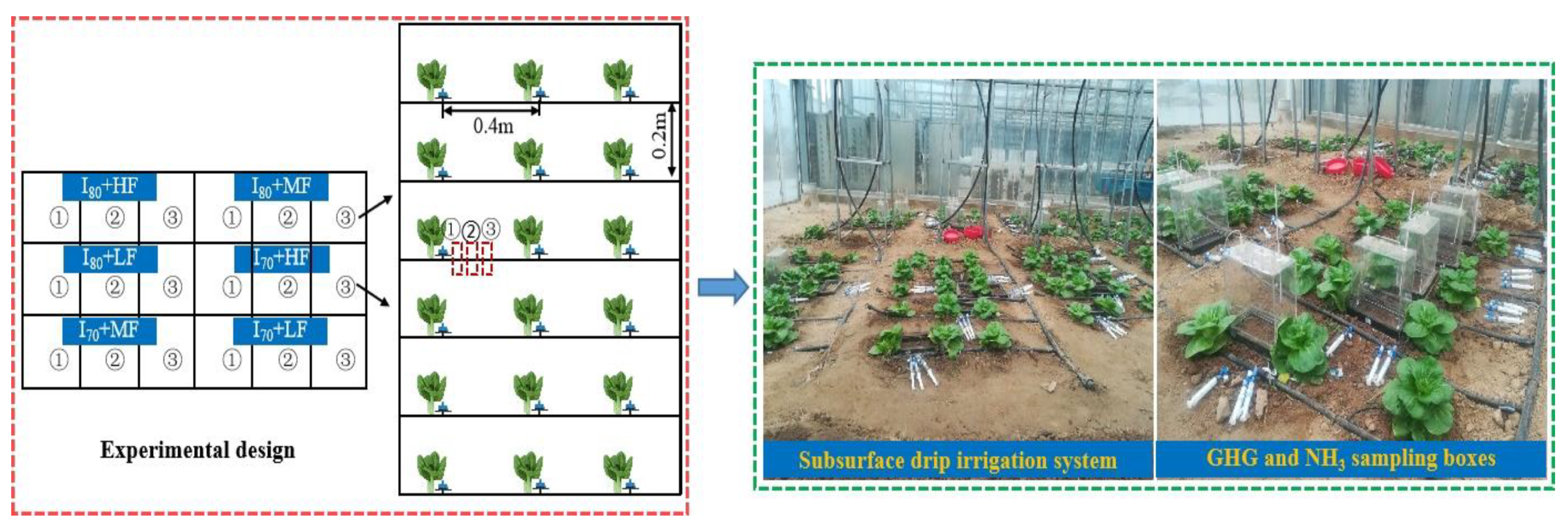
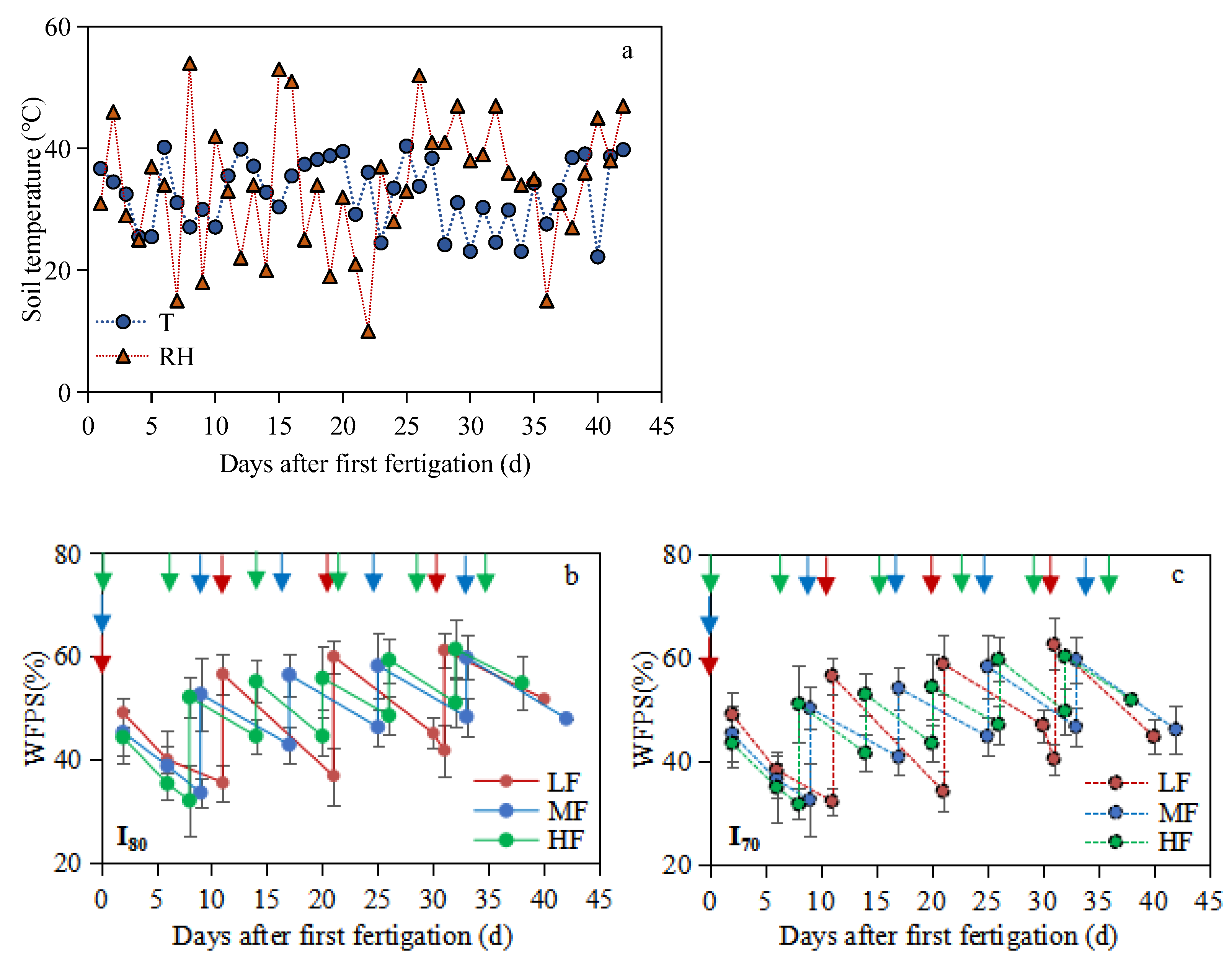
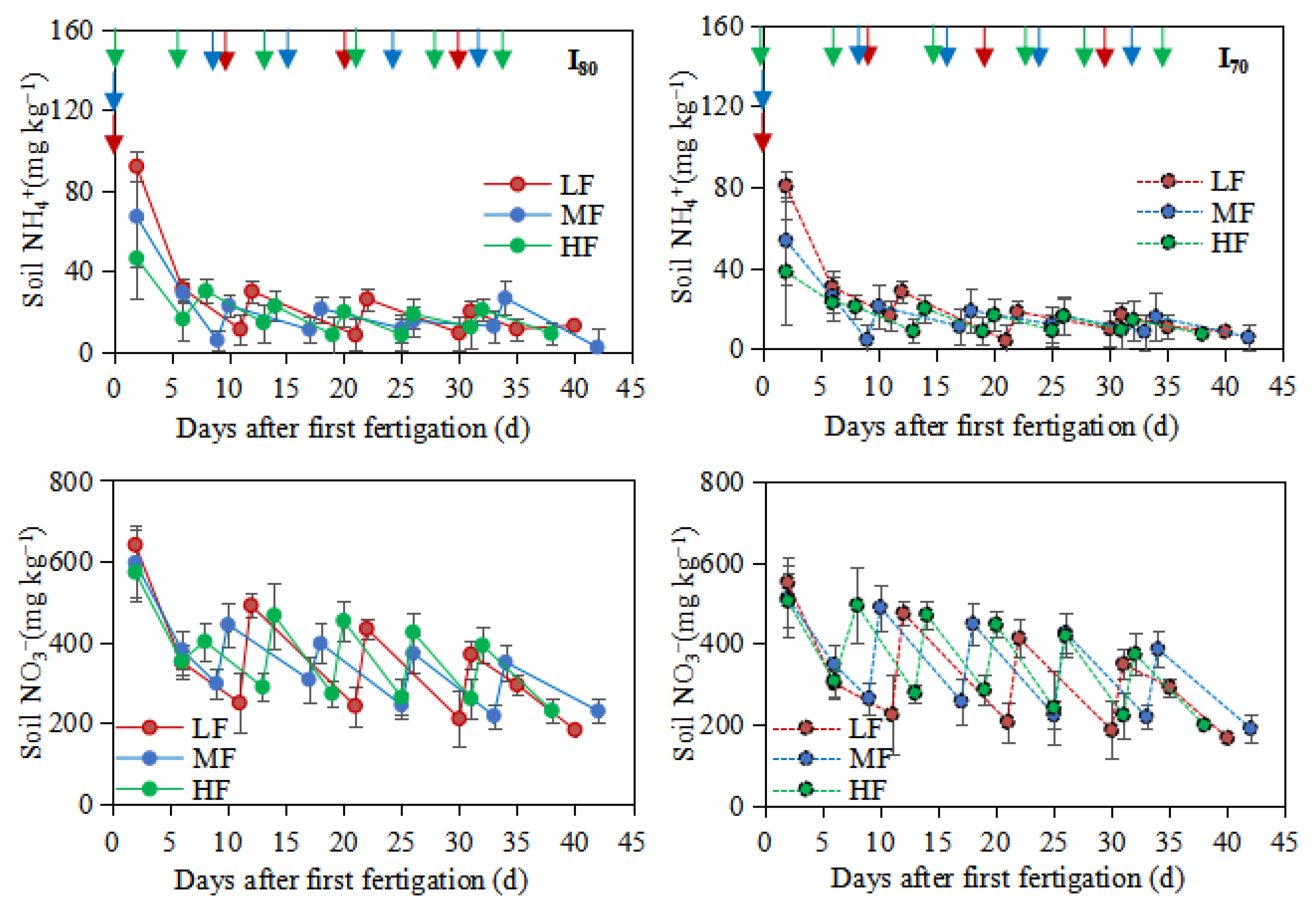
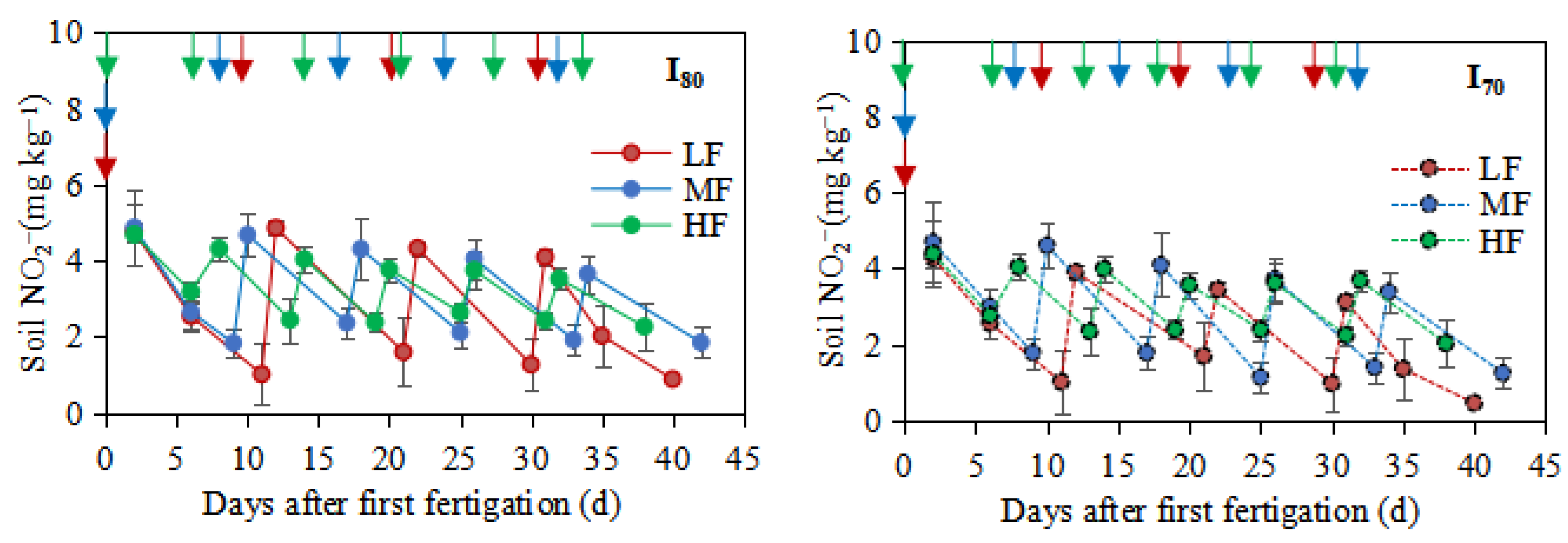
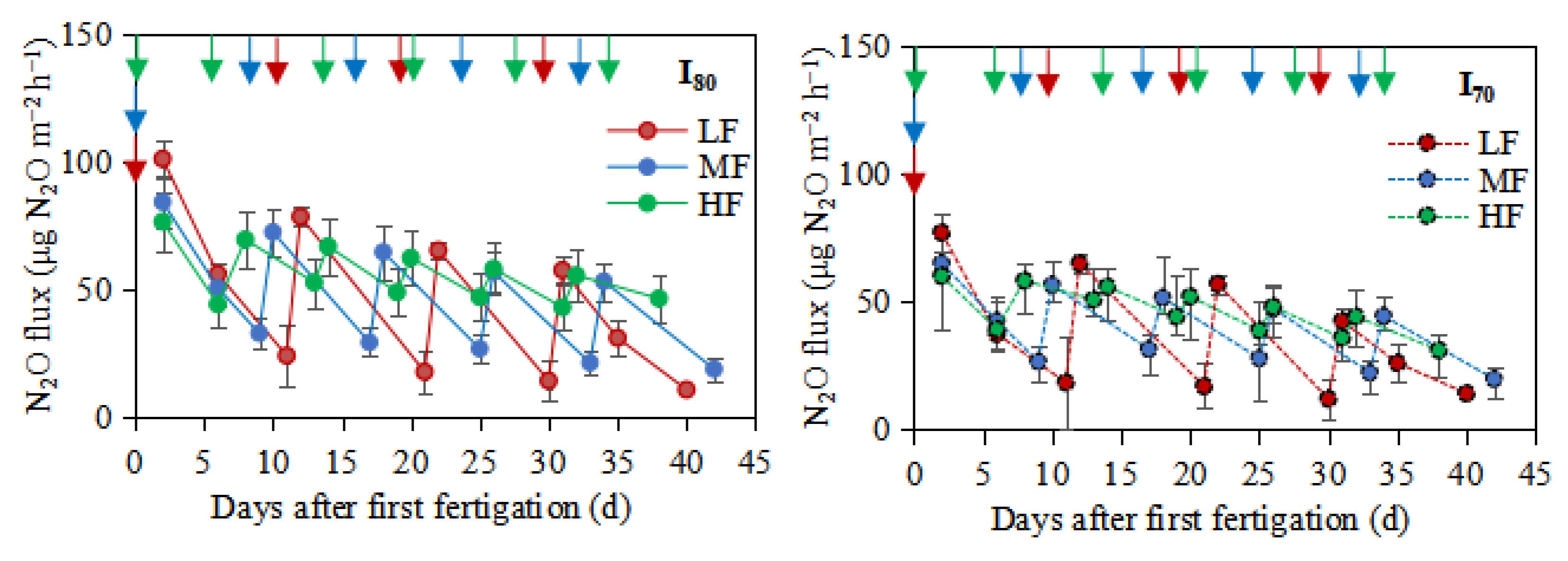

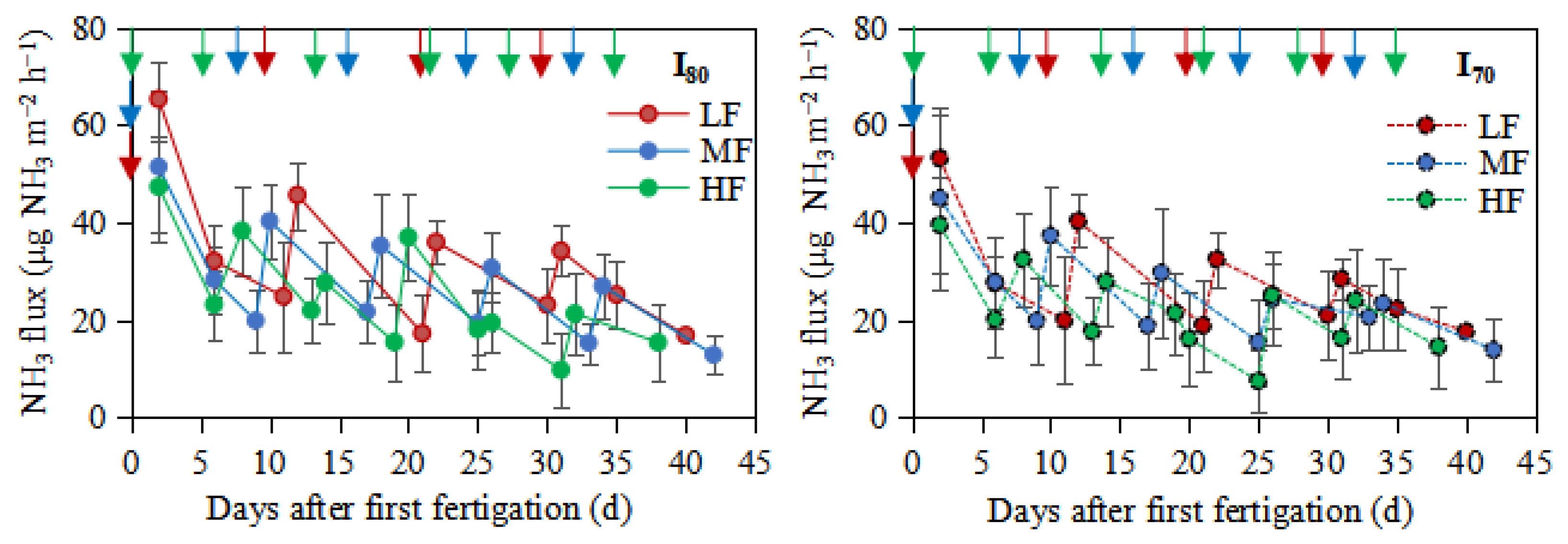

| GHG | Horizontal Distances from Emitter | I80 | I70 | ||||
|---|---|---|---|---|---|---|---|
| LF | MF | HF | LF | MF | HF | ||
| N2O | 1 | 63.4 ± 4.4 a | 60.7 ± 4.2 a | 69.5 ± 4.9 a | 48.2 ± 3.4 a | 48.4 ± 3.4 a | 56.4 ± 3.9 a |
| 2 | 33.5 ± 2.3 c | 36.1 ± 2.5 c | 45.3 ± 3.2 c | 28.7 ± 2.3 c | 32.6 ± 2.3 c | 39.0 ± 2.7 c | |
| 3 | 39.6 ± 2.8 b | 42.2 ± 2.9 b | 52.8 ± 3.7 b | 32.8 ± 2.3 b | 37.3 ± 2.6 b | 43.9 ± 3.1 b | |
| CO2 | 1 | 298.1 ± 20.8 a | 293.8 ± 20.5 a | 336.6 ± 23.5 a | 247.4 ± 17.3 a | 260.9 ± 18.2 a | 302.7 ± 21.2 a |
| 2 | 215.4 ± 15.1 c | 209.4 ±14.6 c | 246.3 ± 17.2 c | 179.6 ± 12.6 c | 198.0 ± 13.8 c | 239.2 ± 16.7 b | |
| 3 | 247.5 ± 17.3 b | 243.7 ± 17 b | 278.2 ± 19.4 b | 220.1 ± 15.4 b | 236.6 ± 16.5 b | 282.1 ± 19.7 a | |
| Irrigation Level (I) | Fertigation Frequency (F) | N2O | CO2 | NH3 |
|---|---|---|---|---|
| (mg N2O m−2) | (g CO2 m−2) | (mg NH3 m−2) | ||
| I80 | LF | 56.48 ± 2.38 a | 309.22 ± 13.02 a | 34.76 ± 1.46 a |
| MF | 57.11 ± 2.40 a | 310.96 ± 13.09 a | 31.86 ± 1.34 b | |
| HF | 57.29 ± 2.41 a | 318.39 ± 13.41 a | 24.99 ± 1.05 e | |
| I70 | LF | 45.14 ± 1.90 b | 273.05 ± 11.50 b | 30.19 ± 1.27 c |
| MF | 46.53 ± 1.96 b | 301.51 ± 12.70 a | 27.79 ± 1.18 d | |
| HF | 46.71 ± 1.97 b | 308.05 ± 12.97 a | 23.34 ± 0.98 f | |
| F | ns | ns | * | |
| I | * | * | * | |
| F × I | ns | ns | ns |
| Irrigation Level | Fertigation Frequencies | Yield (kg m−2) | GWP/Y |
|---|---|---|---|
| (mg CO2 eq kg−1) | |||
| I80 | LF | 1.71 ± 0.12 b | 3.12 ± 0.22 a |
| MF | 1.97 ± 0.14 b | 2.68 ± 0.19 b | |
| HF | 2.48 ± 0.17 a | 2.63 ± 0.18 b | |
| I70 | LF | 1.55 ± 0.07 c | 2.67 ± 0.19 a |
| MF | 1.83 ± 0.08 b | 2.31 ± 0.16 b | |
| HF | 2.31 ± 0.10 a | 2.17 ± 0.15 b | |
| F | * | * | |
| I | * | * | |
| F × I | ns | ns |
Publisher’s Note: MDPI stays neutral with regard to jurisdictional claims in published maps and institutional affiliations. |
© 2022 by the authors. Licensee MDPI, Basel, Switzerland. This article is an open access article distributed under the terms and conditions of the Creative Commons Attribution (CC BY) license (https://creativecommons.org/licenses/by/4.0/).
Share and Cite
Hamad, A.A.A.; Wei, Q.; Xu, J.; Hamoud, Y.A.; He, M.; Shaghaleh, H.; Wei’, Q.; Li, X.; Qi, Z. Managing Fertigation Frequency and Level to Mitigate N2O and CO2 Emissions and NH3 Volatilization from Subsurface Drip-Fertigated Field in a Greenhouse. Agronomy 2022, 12, 1414. https://doi.org/10.3390/agronomy12061414
Hamad AAA, Wei Q, Xu J, Hamoud YA, He M, Shaghaleh H, Wei’ Q, Li X, Qi Z. Managing Fertigation Frequency and Level to Mitigate N2O and CO2 Emissions and NH3 Volatilization from Subsurface Drip-Fertigated Field in a Greenhouse. Agronomy. 2022; 12(6):1414. https://doi.org/10.3390/agronomy12061414
Chicago/Turabian StyleHamad, Amar Ali Adam, Qi Wei, Junzeng Xu, Yousef Alhaj Hamoud, Min He, Hiba Shaghaleh, Qi Wei’, Xintong Li, and Zhiming Qi. 2022. "Managing Fertigation Frequency and Level to Mitigate N2O and CO2 Emissions and NH3 Volatilization from Subsurface Drip-Fertigated Field in a Greenhouse" Agronomy 12, no. 6: 1414. https://doi.org/10.3390/agronomy12061414
APA StyleHamad, A. A. A., Wei, Q., Xu, J., Hamoud, Y. A., He, M., Shaghaleh, H., Wei’, Q., Li, X., & Qi, Z. (2022). Managing Fertigation Frequency and Level to Mitigate N2O and CO2 Emissions and NH3 Volatilization from Subsurface Drip-Fertigated Field in a Greenhouse. Agronomy, 12(6), 1414. https://doi.org/10.3390/agronomy12061414








